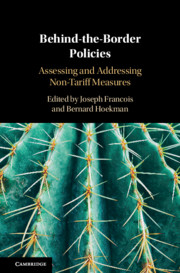Book contents
- Behind-the-Border Policies
- Behind-the-Border Policies
- Copyright page
- Contents
- Figures
- Tables
- Boxes
- Contributors
- 1 Moving beyond the Border
- Part I Concepts and Measurement
- Part II Assessing and Benchmarking Policy
- Part III Dealing with Non-tariff Measures: Legal and Institutional Contexts
- 8 Nontariff Measures Reforms
- 9 Good Regulatory Practices and International Trade
- 10 Rules of Origin as Non-tariff Measures
- 11 Behind-the-Border Measures and the New Generation of Trade Agreements
- 12 Nontariff Responses to China’s Development Strategy
- 13 A Time for Action
- References
- Index
10 - Rules of Origin as Non-tariff Measures
Towards Greater Regulatory Convergence*
from Part III - Dealing with Non-tariff Measures: Legal and Institutional Contexts
Published online by Cambridge University Press: 25 October 2019
- Behind-the-Border Policies
- Behind-the-Border Policies
- Copyright page
- Contents
- Figures
- Tables
- Boxes
- Contributors
- 1 Moving beyond the Border
- Part I Concepts and Measurement
- Part II Assessing and Benchmarking Policy
- Part III Dealing with Non-tariff Measures: Legal and Institutional Contexts
- 8 Nontariff Measures Reforms
- 9 Good Regulatory Practices and International Trade
- 10 Rules of Origin as Non-tariff Measures
- 11 Behind-the-Border Measures and the New Generation of Trade Agreements
- 12 Nontariff Responses to China’s Development Strategy
- 13 A Time for Action
- References
- Index
Summary
Trade agreements require the parties to agree on the rules (regulations) that will determine whether a product is eligible to benefit from whatever provisions are embodied in the agreement. Thus, to be eligible for preferential market access benefits an exporter will need to document that the product has been produced in an eligible country. Such preferential rules of origin (RoO) have been the focus of much research, lobbying and policy debate. To a significant extent the more difficult it is for exporters to satisfy RoO – the more restrictive or stringent the RoO are – the less valuable preferential access will be. Less well-known and studied are non-preferential RoO. These are needed to determine whether a product is subject to a nation’s trade policy. For example, if the EU imposes an anti-dumping measure on imports of a product originating in China, there is need to determine the origin of that product to avoid possible circumvention. The same is true when it comes to access to government procurement markets: if India opens up access to public procurement contracts to firms from China, it will be necessary to determine whether goods are eligible – i.e. what constitutes a Chinese product. More generally, all countries regulate what constitutes the origin of a product (so-called marks of origin or country of origin labelling) for consumer information reasons, to be able to implement health and safety–related regulations, for statistical purposes, and so forth.
Information
- Type
- Chapter
- Information
- Behind-the-Border PoliciesAssessing and Addressing Non-Tariff Measures, pp. 209 - 245Publisher: Cambridge University PressPrint publication year: 2019
Accessibility standard: Unknown
Why this information is here
This section outlines the accessibility features of this content - including support for screen readers, full keyboard navigation and high-contrast display options. This may not be relevant for you.Accessibility Information
- 1
- Cited by
